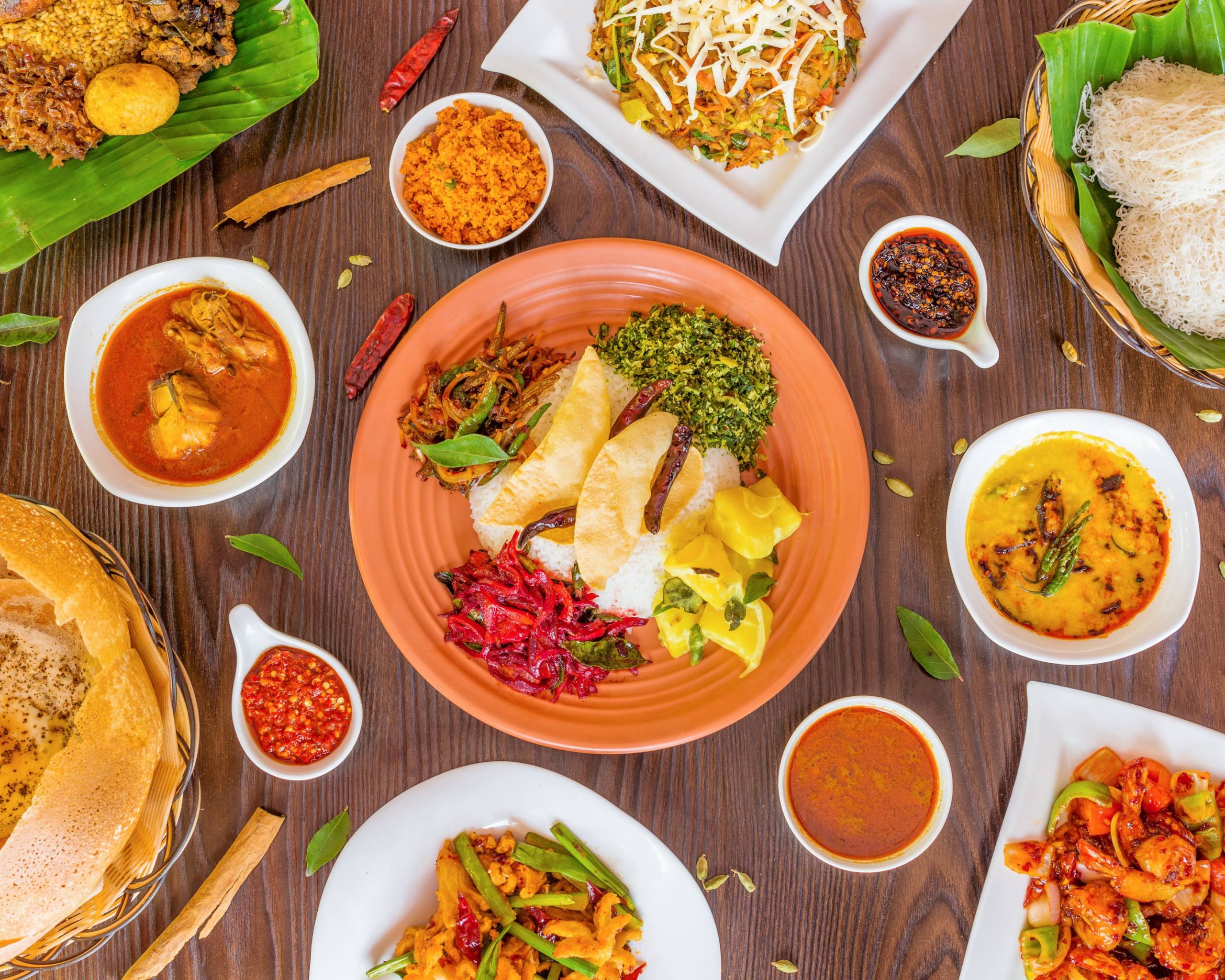Author: Shaima Nizar
Sri Lanka stakes a claim to having the oldest living tree known to be planted by man, the Sri Maha Bodhi in Anuradhapura, which has been around for over 2,000 years. Legend says it was grown from a sapling brought from the Bodh Gaya in India, the tree under which the Buddha is said to have found enlightenment. But this is no fossilized museum country. Sri Lanka’s got food clout; maybe not the Michelin Award-winning kind, but the ancient and cultural kind. It’s most visible in Colombo (population: 2,251,274), the city named by the Portuguese, but believed to be derived from the classical Sinhala name Kolon thota, meaning “port on the river Kelani”.
Locals don’t just preserve and celebrate their food traditions, they live them—incorporating the typically hearty, occasionally weird (to foreigners), but always authentic recipes into their everyday lives. Over the years, I’ve noticed how some local cooks will argue for hours over the preparation and origin of particular dishes. Sri Lankan food is always a matter of regional pride. The influences on the island’s cuisine range from the colonial (Portuguese, Dutch, and British) to South Indian to completely indigenous. Where other aspects of culture may have faded, food has been passed on from one generation to another in the form of heirloom recipes, and through it, one can understand the history and journey of this country.
The most difficult thing about eating in this island is that you can’t try everything. Every day you have a finite number of meals, and a finite amount of space in your stomach, while there seems to be an infinite number of local dishes that you undeniably need to try. When in Sri Lanka, eat as the Lankans do. Travelers should definitely try to get their hands on some of the country’s quintessential dishes, so, without further ado, here are 5 local staples to add to your taste list:
Isso Wade
Walking down the street, the aroma of a fried spicy lentil-based patty topped with prawns, mixed with the humidity of a Sri Lankan evening, was a combination that switched on my senses. Isso wade is a must-eat street side food. Once fried, they are best served with an onion garnish and gravy. Try the street hawkers at Galle Face Green for fresh Isso Wade.

Isso Wade
Walking down the street, the aroma of a fried spicy lentil-based patty topped with prawns, mixed with the humidity of a Sri Lankan evening, was a combination that switched on my senses. Isso wade is a must-eat street side food. Once fried, they are best served with an onion garnish and gravy. Try the street hawkers at Galle Face Green for fresh Isso Wade.
Kothu (may also be spelled as Kottu or Koththu on menus)
If you haven’t eaten kothu in Sri Lanka, you haven’t lived! A spicy concoction of textures brought about by Tamil and Muslim cultures, it’s made with roti (bread), eggs, vegetables, and an assortment of spices, gravy and meat. Despite its labour-intensive preparation (two sharp metal spatulas are used to demolish the roti/bread into smaller pieces), it is available throughout the country from the smallest roadside shops to epicurean restaurants. Kothu is a hearty yet affordable meal, making it the island’s favourite comfort food. Our recommendation: try the kottu at roadside eatery Plaza in Colombo 3.

Kothu (may also be spelled as Kottu or Koththu on menus)
If you haven’t eaten kothu in Sri Lanka, you haven’t lived! A spicy concoction of textures brought about by Tamil and Muslim cultures, it’s made with roti (bread), eggs, vegetables, and an assortment of spices, gravy and meat. Despite its labour-intensive preparation (two sharp metal spatulas are used to demolish the roti/bread into smaller pieces), it is available throughout the country from the smallest roadside shops to epicurean restaurants. Kothu is a hearty yet affordable meal, making it the island’s favourite comfort food. Our recommendation: try the kottu at roadside eatery Plaza in Colombo 3.
Traditional Rice & Curry
Sri Lanka’s staple dish, the one consumed daily in pretty much every single household, is rice alongside an assortment of vegetables and fish/meats that are flavoured with sliced onions, green chillies, black pepper, cinnamon, cardamom, cloves, nutmeg and saffron. The most famous type of rice and curry is one that includes fish, beef or chicken curry (a gravy that is spiced and cooked with coconut milk), two to three different vegetables, one portion of the fried crispy side dish known as papadam, and a mallum consisting of chopped leaves mixed with freshly ground coconut. Around lunchtime in Colombo, you can find street vendors selling rice & curry packets or use this list. You can also search on Uber Eats in Sri Lanka for Rice & Curry.

Traditional Rice & Curry
Sri Lanka’s staple dish, the one consumed daily in pretty much every single household, is rice alongside an assortment of vegetables and fish/meats that are flavoured with sliced onions, green chillies, black pepper, cinnamon, cardamom, cloves, nutmeg and saffron. The most famous type of rice and curry is one that includes fish, beef or chicken curry (a gravy that is spiced and cooked with coconut milk), two to three different vegetables, one portion of the fried crispy side dish known as papadam, and a mallum consisting of chopped leaves mixed with freshly ground coconut. Around lunchtime in Colombo, you can find street vendors selling rice & curry packets or use this list. You can also search on Uber Eats in Sri Lanka for Rice & Curry.
Seafood
Home to thousands of miles of coastline, it is no wonder that Sri Lanka has so many dishes with seafood acting as the main ingredient. One of the best things to try down south is the seafood, and you get that in abundance. From lagoon mud crab to jumbo prawns, lobsters and cuttlefish, the island has a great basket of seafood to offer. When in Colombo’s southern suburbs, travellers ought to try a meaty lagoon crab curry and hot butter cuttlefish. The latter is tempura-crusted calamari, which is deep-fried until it is incredibly crisp and golden brown with a spicy Lankan twist; the recipe calls for tons of dry chilies and spring onions. Lovers of prawns should try an authentic coconut milk-based prawn curry, while another local favourite is the Ambulthiyal, a spicy and sour fish curry.

Seafood
Home to thousands of miles of coastline, it is no wonder that Sri Lanka has so many dishes with seafood acting as the main ingredient. One of the best things to try down south is the seafood, and you get that in abundance. From lagoon mud crab to jumbo prawns, lobsters and cuttlefish, the island has a great basket of seafood to offer. When in Colombo’s southern suburbs, travellers ought to try a meaty lagoon crab curry and hot butter cuttlefish. The latter is tempura-crusted calamari, which is deep-fried until it is incredibly crisp and golden brown with a spicy Lankan twist; the recipe calls for tons of dry chilies and spring onions. Lovers of prawns should try an authentic coconut milk-based prawn curry, while another local favourite is the Ambulthiyal, a spicy and sour fish curry.
Curd & Kithul Treacle
This sweet treat is sometimes served at the end of a special meal, but more often enjoyed on its own as a morning or midday snack. This rich, flavoured buffalo curd and kithul treacle (syrup from a type of palm tree) is a popular year-round dessert. The curd tastes similar to Greek yoghurt, and is served with a syrup made from kithul to complement its tangy flavour. This will generally be listed under dessert on the menu of restaurants serving Sri Lankan food.

Curd & Kithul Treacle
This sweet treat is sometimes served at the end of a special meal, but more often enjoyed on its own as a morning or midday snack. This rich, flavoured buffalo curd and kithul treacle (syrup from a type of palm tree) is a popular year-round dessert. The curd tastes similar to Greek yoghurt, and is served with a syrup made from kithul to complement its tangy flavour. This will generally be listed under dessert on the menu of restaurants serving Sri Lankan food.
There’s something whimsical and optimistic about both the people and food in this little island nation. Sri Lankans get just as excited as tourists when presented with a plate of rice and curry, or while standing at a street vendor stall. This brazen enthusiasm for eating, as well as an abundance of fascinating ingredients and influences, has generated a truly fun and diverse food scene.


